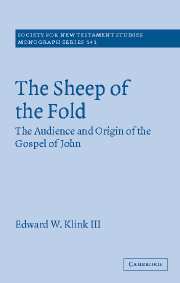Book contents
- Frontmatter
- Contents
- Acknowledgments
- List of abbreviations
- 1 The audience and origin of the Gospels: introduction and method
- 2 Early Christian community: a study of the community construct and its functional potential in early Christianity
- 3 Early Christian Gospel: Gospel genre and a critique of the two-level reading of the Gospel of John
- 4 Early Christian reader: an explication of the audience of the fourth Gospel by inquiring for the implied reader
- 5 Reading the fourth Gospel: the function of the Gospel of John in light of the Gospel community debate
- 6 The sheep of the fold: summary and conclusion
- Bibliography
- Index
4 - Early Christian reader: an explication of the audience of the fourth Gospel by inquiring for the implied reader
Published online by Cambridge University Press: 22 September 2009
- Frontmatter
- Contents
- Acknowledgments
- List of abbreviations
- 1 The audience and origin of the Gospels: introduction and method
- 2 Early Christian community: a study of the community construct and its functional potential in early Christianity
- 3 Early Christian Gospel: Gospel genre and a critique of the two-level reading of the Gospel of John
- 4 Early Christian reader: an explication of the audience of the fourth Gospel by inquiring for the implied reader
- 5 Reading the fourth Gospel: the function of the Gospel of John in light of the Gospel community debate
- 6 The sheep of the fold: summary and conclusion
- Bibliography
- Index
Summary
After looking at the Gospel as a text, we now turn to its reader. We argued in chapter 2 that the language of the FG is not “insider” or antilanguage and that the Gospel “community” should be pictured as much broader than the sectarian-like groups normally supposed. We argued in chapter 3 that the very nature of an early Christian “Gospel” and its relation to the bios genre cannot define the audience of the text, but certainly make a local “community” reading rare or specialized. We also critiqued Martyn's two-level reading of John and presented a case for a “literal” reading of the Gospel text appropriate to the first century. But what type of audience does the narrative expect?
Narrative criticism has often been used by historical critics to define more clearly the audience a text would have expected. Of course, the recovery of the audience of a text is immediately faced with a dilemma: it is easier to determine if a text was written for a local, homogeneous group rather than a general audience, than it is to distinguish between a general (non-localized) audience and a local group that is heterogeneous. Our focus, then, will be specifically on noting possible distinctions in the text between a local, heterogeneous audience and a general audience. Thus, since even “community” interpreters assume the JComm was heterogeneous, we will also begin with that assumption; for a heterogeneous audience is congenial to our proposed audience.
Information
- Type
- Chapter
- Information
- The Sheep of the FoldThe Audience and Origin of the Gospel of John, pp. 152 - 184Publisher: Cambridge University PressPrint publication year: 2007
